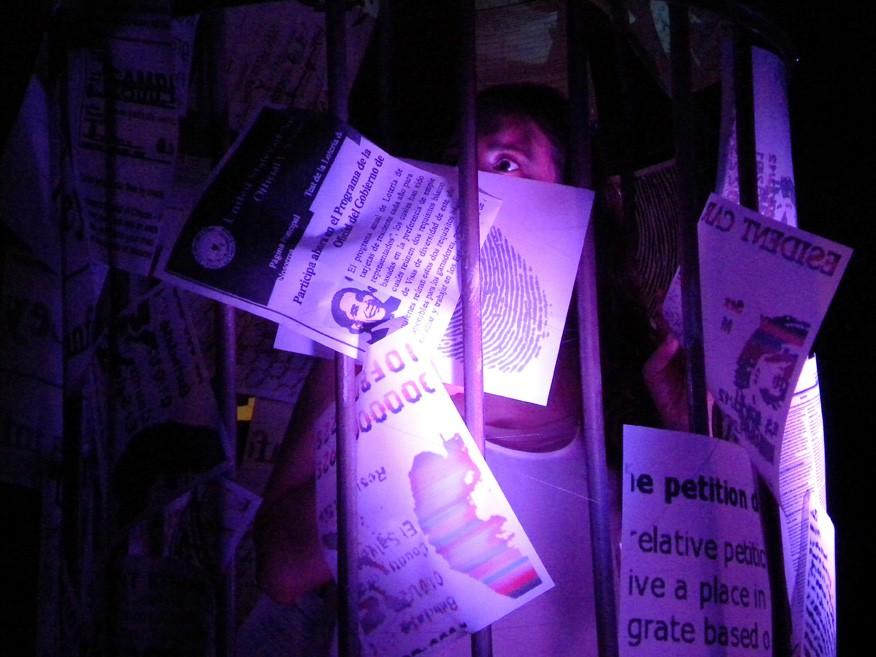“I am Border Patrol.”
This was the first line of audible dialogue that spectators at the new multimedia performance “Dreams and Silhouettes/Suenos y Silhuetas”, heard amidst the sound of blaring police sirens on Saturday.
Staged in the back room of the Global Justice Center, this post-modern art piece wove together paint, projection slides and political propaganda that portrayed the U.S. Border Patrol as antagonist. The director, Denise Uyehara, characterized the Border Patrol as an unscrupulous demagogue in the narrative about immigrants living under the constant threat of deportation. The use of a booming loudspeaker and ominous voice added to an Orwellian atmosphere.
The focus of the performance was recorded testimonies of anonymous women from the Tucson community, women who offered authentic stories of struggle and survival.
The words of these women were projected alongside images of empty desert landscape. One of the stories came from a woman who spent five years studying to become a computer programmer, but now works as a dishwasher in a hotel kitchen.
The audience got a glimpse of the theme of oppression before the performance even began. As spectators stood together around a bare stage, the only fixture they saw was a giant birdcage plastered with copies of documentation papers — pieces of bureaucracy that can symbolize freedom or humiliation for immigrants.
While spectators continued filing into the performance space, one of the actresses quietly slipped into a birdcage. She remained completely silent as she covered the birdcage with fragments of American identification cards and permanent resident documents. Her imprisonment was accompanied by the chirps of birds over the loudspeaker, which served as a poignant reminder of hope for people who feel entrapped in a place they’ve always considered home. The birdcage was just one of many symbols profiled in this conglomeration of art and media.
As the words and whispers of women filled the room with testimonies of suffering, three artists dressed in black emerged from the shadows and began to paint a mural onstage.
The giant white canvas originally displayed the outline of five individuals. The muralists filled in their silhouettes with various lines, shapes and colors to symbolize the hopes and ambitions of immigrant women.
“It’s our responsibility to make people more aware,” said Cristina Cardenas, one of the three muralists who changed the white canvas into a pictorial arrangement of chaos and beauty.
Cardenas painted her silhouette with a bright red graduation cap and diploma. As an immigrant woman from Mexico, Cardenas said that she understands the precious value of education. She graduated with a degree in printmaking from the UA.
The performance in general tried to inform the audience of radical legislation like Operation Streamline — a policy initiated by the Department of Homeland Security in 2005 that allows for the swift prosecution of unauthorized migrants.
Some audience members had less political objectives while viewing the performance. Gloria Valia, a woman from Chile visiting the U.S. for the first time, said that she attends performance pieces like this to simply practice her English-speaking skills.
“You don’t have a problem like this in Chile,” said Valia, who is participating in a UA study abroad program this semester. Valia said that her home country is much more welcoming to people from its neighboring countries, and that this performance accurately displayed the harsh reality of foreign policy in the U.S.
One of the most effective elements of the performance was an ensemble of actors who mimed little vignettes of the migrant experience in Tucson. The ensemble’s ivory clothing worked as a symbol of the loss of individualism that migrants undergo once they earn the stamp of “illegal immigrant.”
In a sequence where a menacing Border Patrol officer’s emotionless voice thundered over the loudspeaker, the ensemble of actors lined up as if they were about to be shot by a firing squad. Two of the actors simulated a violent rendition of the game red rover, in which they took turns attempting to run past each other. Neither was successful in breaking through the barrier.
The performance ended with the ensemble walking a trail of more copies of citizenship documents. They each began picking up scraps of clothing and covering their bleak, white wardrobe with distinctive signs.
The performance was an uplifting reminder that a human’s right to freedom is stronger than any oppressive border law. It seemed to say that despite the Border Patrol’s ability to strip away the goals of working-class immigrants, it cannot whitewash their identities. The overarching message of “Dreams and Silhouettes/Suenos y Silhuetas,” embraced how identity is best encompassed in the soul, not on a piece of paper.









